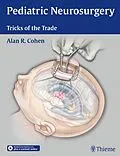First prize from the 2016 BMA Medical Book Awards for Surgical Specialties!
Winner of the 2017 PROSE Awards for Textbook/Clinical Medicine
This state-of-the-art volume is an unparalleled teaching tool that reveals invaluable tricks of the trade. It is an essential resource for pediatric and general neurosurgeons, neurosurgery residents and fellows.
Pediatric Neurosurgery is a uniquely exacting subspecialty in which surgeons are given the extraordinary privilege of alleviating suffering for gravely ill children, and in best-case scenarios, restoring their health. Understanding the vast and complex anatomy, pathology, and pathophysiology that evolves throughout childhood presents considerable challenges. Further, the field is rapidly progressing with advancements in neurodiagnostic imaging and surgical instrumentation, as well as an expanding knowledge of the molecular and genetic bases underlying many neurosurgical disorders.
While this book's primary focus is on how to achieve technical excellence in the OR, this is a remarkably personal book about the art of pediatric neurosurgery. In it you will find wisdom gained from decades of experience. Read this book, use the knowledge you gain from it, and you will become a safer, more skillful neurosurgeon.
Special Features:
- More than 800 stunning, full-color illustrations
- Online access to videos in which experts from all over the world demonstrate the operative nuances and techniques that help surgeons get patients safely in and out of the OR
- Written by master surgeons from 10 countries who share a wealth of insightful wisdom garnered from years of experience, refinement of surgical techniques, and development of numerous innovations
- Surgical pearls, operative nuances, procedural modifications, and techniques for avoiding and dealing with pitfalls
Zusammenfassung
First prize from the 2016 BMA Medical Book Awards for Surgical Specialties!
Winner of the 2017 PROSE Awards for Textbook/Clinical Medicine
This state-of-the-art volume is an unparalleled teaching tool that reveals invaluable tricks of the trade. It is an essential resource for pediatric and general neurosurgeons, neurosurgery residents and fellows.
Pediatric Neurosurgery is a uniquely exacting subspecialty in which surgeons are given the extraordinary privilege of alleviating suffering for gravely ill children, and in best-case scenarios, restoring their health. Understanding the vast and complex anatomy, pathology, and pathophysiology that evolves throughout childhood presents considerable challenges. Further, the field is rapidly progressing with advancements in neurodiagnostic imaging and surgical instrumentation, as well as an expanding knowledge of the molecular and genetic bases underlying many neurosurgical disorders.
While this book's primary focus is on how to achieve technical excellence in the OR, this is a remarkably personal book about the art of pediatric neurosurgery. In it you will find wisdom gained from decades of experience. Read this book, use the knowledge you gain from it, and you will become a safer, more skillful neurosurgeon.
Special Features:
- More than 800 stunning, full-color illustrations
- Online access to videos in which experts from all over the world demonstrate the operative nuances and techniques that help surgeons get patients safely in and out of the OR
- Written by master surgeons from 10 countries who share a wealth of insightful wisdom garnered from years of experience, refinement of surgical techniques, and development of numerous innovations
- Surgical pearls, operative nuances, procedural modifications, and techniques for avoiding and dealing with pitfalls
Inhalt
<p><strong>Section I Introduction</strong><br>1 Basic Surgical Technique<br>2 Diagnostic Procedures<br>3 Neuroanesthesia<br>4 Pre- and Postoperative Management of the Neurosurgical Patient<br>5 Pediatric Neurosurgical Positioning<br>6 Intraoperative Neurophysiological Monitoring During Pediatric Neurosurgical Procedures<br>7 Surgical Safety<br><strong>Section II Neurology</strong><br>8 Neonatal Neurologic Examination<br>9 Neurologic Examination of the Child and Adolescent<br><strong>Section III Congenital Malformations</strong><br><strong><em>Section III.A Malformations of the Scalp and Skull</em></strong><br>10 Congenital Defects of the Scalp and Skull<br>11 Deformational Plagiocephaly<br>12 Nonsyndromic Synostosis: Overview<br>13 Sagittal Synostosis Repair Surgery<br>14 Operative Techniques in Cranial Vault Reconstruction: Nonsyndromic Coronal Craniosynostosis<br>15 The Surgical Repair of Unilateral Coronal Synostosis<br>16 The Surgical Repair of Metopic Synostosis<br>17 Syndromic Craniosynostosis<br>18 Minimally Invasive Craniosynostosis Surgery<br>19 External Distraction for Frontofacial Advancement<br>20 The Surgical Management of Craniopagus Twins<br><strong><em>Section III.B Malformations of the Brain</em></strong><br>21 Malformations of the Cerebral Hemispheres<br>22 Occipital Encephalocele<br>23 Surgical Approach to Sphenoethmoidal Encephaloceles<br>24 The Chiari I Malformation<br>25 The Chiari II Malformation<br><strong><em>Section III.C Malformations of the Spine</em></strong><br>26 Craniocervical Junction Abnormalities in Children<br>27 Disorders of the Vertebral Column<br>28 Spinal Deformity/Kyphosis<br>29 Scoliosis<br><strong><em>Section III.D Malformations of the Spinal Cord</em></strong><br>30 Myelomeningocele<br>31 Tight Filum Terminale<br>32 Spinal Tethering Tracts<br>33 Spinal Lipomas<br>34 Split Cord Malformation: From Gastrulation to Operation<br>35 Congenital Spinal Cysts<br><strong>Section IV Hydrocephalus and Disorders of Cerebrospinal Fluid Circulation</strong><br>36 The Pathophysiology and Classification of Hydrocephalus<br>37 Ventricular Shunting for Hydrocephalus<br>38 Endoscopic Treatment of Hydrocephalus<br>39 Congenital Intracranial Cysts<br>40 The Dandy-Walker Malformation<br>41 Idiopathic Intracranial Hypertension<br><strong>Section V Trauma</strong><br>42 Management of Pediatric Scalp Injuries<br>43 Skull Fractures<br>44 Traumatic Brain Injury<br>45 Penetrating Head Injuries<br>46 Vascular Injuries<br>47 Abusive Head Injuries<br>48 Cranioplasty<br>49 Neurointensive Care of Head Injuries<br>50 Pediatric Vertebral Column and Spinal Cord Injuries<br>51 Brachial Plexus Birth Injuries<br><strong>Section VI Neoplasms</strong><br>52 Molecular and Genetic Advances in the Treatmen…
